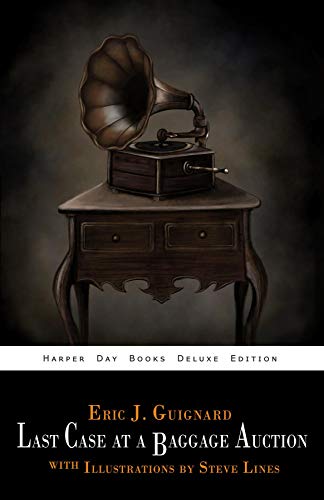 By ERIC J. GUIGNARD (Harper Day Books; 2020)
By ERIC J. GUIGNARD (Harper Day Books; 2020)
This novella has a set-up that is, as they say, a grabber. Set in Detroit, circa 1963, it’s about Charlie, a compulsive hoarder who narrates the story, and who, together with his pal Joey, likes to bid on discarded items. Their latest acquisition is an old suitcase that when opened reveals an antique gramophone player and some records to go with it. When those records are played they emit an eerie chanting that initially seems off-putting, but proves quite addictive and even hypnotic. Joey finds himself overcome by the chanting, falling completely under its spell. This leaves Charlie (who still has his wits about him) to find out who the suitcase and its unholy contents might have belonged to, and why the records exert such a mysterious power.
I’ll refrain from revealing what Charlie’s investigations turn up, other than to say that they involve a dark historical personage (no, it’s not Adolph Hitler or the Marquis de Sade) whose addition to the book is as delightfully unexpected as it is menacing. This takes the story in a supernaturally oriented direction, although it never loses the character-based drama of the earlier passages.
LAST CASE AT A BAGGAGE AUCTION was initially published in 2013 as part of a short-lived series of double novels (paired with a novella by Lisa Morton) patterned on the old Ace Doubles. This 2020 standalone publication is billed as the author’s preferred version, issued under its intended title (which was initially changed to the dreadful BAGGAGE OF ETERNAL NIGHT) and with black and white illustrations by artist Steve Lines that wouldn’t look out of place in a horror-noir graphic novel.
This is the third major work I’ve read by Eric J. Guignard, following the collection THAT WHICH GROWS WILD and the novel DOORWAYS TO THE DEADEYE, and it exhibits all the attributes I’ve come to expect. The prose is smooth and uncluttered, in service of a fully rounded, intelligent and consistently surprising narrative that’s packed with the type of thrills you’d expect from a scary book, along with a great deal of sumptuously researched historical detail (with an unshowy portrayal of early 1960s America that’s never less than fully convincing) and, in the final pages, an overpowering poignancy.
